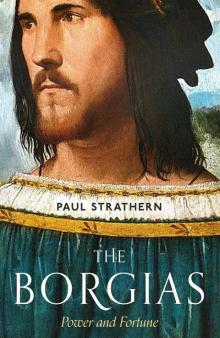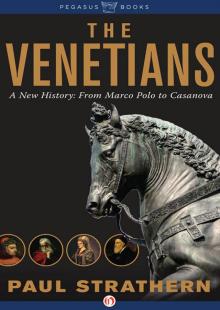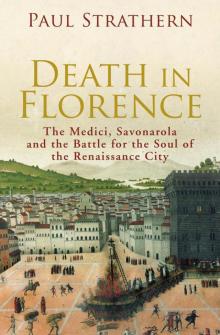- Home
- Paul Strathern
The Borgias
The Borgias Read online
THE
BORGIAS
ALSO BY PAUL STRATHERN
Mendeleyev’s Dream
Dr Strangelove’s Game
The Medici
Napoleon in Egypt
The Artist, the Philosopher and the Warrior
Death in Florence
The Spirit of Venice
The Venetians
First published in Great Britain in 2019 by Atlantic Books,
an imprint of Atlantic Books Ltd.
Copyright © Paul Strathern, 2019
The moral right of Paul Strathern to be identified as the author
of this work has been asserted by him in accordance with the
Copyright, Designs and Patents Act of 1988.
All rights reserved. No part of this publication may be reproduced,
stored in a retrieval system, or transmitted in any form or by any means,
electronic, mechanical, photocopying, recording, or otherwise, without
the prior permission of both the copyright owner and
the above publisher of this book.
Map artwork by Jeff Edwards
1 2 3 4 5 6 7 8 9
A CIP catalogue record for this book is available
from the British Library.
Hardback ISBN: 978-1-78649-544-0
Trade paperback ISBN: 978-1-78649-964-6
Paperback ISBN: 978-1-78649-546-4
E-book ISBN: 978-1-78649-545-7
Printed in Great Britain
Atlantic Books
An Imprint of Atlantic Books Ltd
Ormond House
26–27 Boswell Street
London
WC1N 3JZ
www.atlantic-books.co.uk
To
Julian Alexander
agent extraordinaire
CONTENTS
Maps
Abbreviated Borgia Family Tree
Dramatis Personae
Prologue: The Crowning Moment
1 Origins of a Dynasty
2 The Young Rodrigo
3 Cardinal Rodrigo Borgia Emerges in His True Colours
4 The Way to the Top
5 A New Pope in a New Era
6 ‘The Scourge of God’
7 The Best of Plans . . .
8 A Crucial Realignment
9 A Royal Connection
10 Il Valentino’s Campaign
11 Biding Time
12 The Second Romagna Campaign
13 The Borgias in excelsis
14 Cesare Strikes Out
15 Changing Fortunes
16 Cesare Survives
17 Borgia’s ‘Reconciliation’
18 Lucrezia in Ferrara
19 The Unforeseen
20 Desperate Fortune
Epilogue
Acknowledgements
Sources
Illustrations
Index
ABBREVIATED BORGIA FAMILY TREE
DRAMATIS PERSONAE
This list is not exhaustive. If any names you are looking for do not appear, try looking up the page of their first entry in the Index.
Alexander VI Born Rodrigo Borgia, he rose during the papacy of his uncle, who became Pope Callixtus III.
Alfonso II Son of King Ferrante I of Naples, whom he succeeded as short-lived King of Naples.
King Alfonso of Aragon Made controversial heir to the throne of Naples by Joanna II. The future Callixtus III became his secretary.
Georges d’Amboise Archbishop of Rouen and a powerful influence at the French royal court.
Alfonso of Aragon, Duke of Bisceglie Illegitimate son of King Alfonso II of Naples, whose father was Ferrante I. Alfonso became Lucrezia’s beloved second husband.
Sancia of Aragon Spirited childhood friend of Lucrezia Borgia, who fell in and out of favour with Alexander VI.
Cardinal Basilios Bessarion Greek scholar who was at one time a candidate for the papacy.
Pietro Bembo Venetian poet who wrote sonnets to Lucrezia Borgia when she was living in Ferrara and married to the Duke of Ferrara.
Alonso de Borja See Callixtus III.
Cesare Borgia Oldest son of Vanozza de’ Cattanei and Cardinal Rodrigo Borgia, the future Alexander VI.
Giovanni Borgia Known as the Infans Romanus; the child who appeared in the Borgia family, whose parentage became a source of scandalous speculation.
Isabella Borgia Sister of Callixtus III, mother of Rodrigo, who became Alexander VI.
Juan Borgia Younger brother of Cesare Borgia, who much resented him.
Jofrè Borgia Fourth child of Rodrigo Borgia by Vanozza de’ Cattanei.
Lucrezia Borgia Daughter of Alexander VI, who married her off several times in pursuance of his political goals.
Pedro Luis Borgia Nephew of the man who would become Callixtus III, appointed by his uncle as Captain-General of the Papal Forces.
Cardinal Rodrigo Borgia See Alexander VI.
Pedro Calderon Nicknamed ‘Perotto’, who was Alexander VI’s unfortunate chamberlain.
Callixtus III, born Alfonso de Borja, the first Borgia Pope, who gave his nephew Rodrigo Borgia the all-important post of Vice-Chancellor.
Cardinal Angelo Capranica Loyal friend to Callixtus III.
Vanozza de’ Cattanei Mistress of Cardinal Rodrigo Borgia (Alexander VI) and mother of Cesare, Juan, Lucrezia and Jofrè.
Charles VIII The young King of France who invaded Italy.
Miguel da Corella Known as ‘the strangler’, one of Cesare Borgia’s closest Spanish commanders.
Alfonso d’Este Son of Ercole I d’Este, was ruler of Ferrara, became third husband of Lucrezia Borgia.
Ercole I d’Este Military leader, Duke of Ferrara, who grudgingly allowed his son to marry Lucrezia Borgia.
Isabella d’Este Cultured Marquesa of Mantua, who disliked Lucrezia Borgia. Had her portrait sketched by Leonardo.
Fiammetta de’ Michaelis The renowned Roman courtesan whom Cesare took as his mistress during the summer of 1500.
Giulia Farnese Sixteen-year-old who became mistress to the fifty-eight-year-old Alexander VI.
Ferrante I The long-lived King of Naples, whose death triggered the invasion of Italy by Charles VIII of France.
Francesco Gonzaga Duke of Mantua and husband to Isabella d’Este.
Francesco Guicciardini A contemporary historian and friend of Machiavelli.
Innocent VIII The Pope who preceded Alexander VI.
Joanna of Aragon At twenty-three became the second wife of the ageing King Ferrante I, and thus became Queen of Naples. Not to be mistaken for the earlier Queen Joanna II of Naples (see below) who had died before she was born.
Queen Joanna II of Naples Aged ruler of Naples who made Alfonso of Aragon her heir, thus antagonizing French claimants to the throne.
Ramiro da Lorqua Cesare Borgia’s most trusted Spanish commander.
Louis XII Formerly Louis of Orléans, who succeeded to the French throne after Charles VIII.
Cardinal Giovanni de’ Medici Son of Lorenzo de’ Medici, who would became a cardinal aged thirteen, but fled Rome when Alexander VI became pope.
Lorenzo de’ Medici Also known as ‘the Magnificent’, the ruler of Florence.
Niccolò Machiavelli Notorious author of The Prince, contemporary historian and emissary for Florence to Cesare Borgia.
Federigo da Montefeltro Renowned condottiere who transformed Urbino into a Renaissance city.
Guidobaldo da Montefeltro Son of Federigo, who became a sworn enemy of Cesare Borgia.
Oliverotto da Fermo Originally a loyal commander of Cesare Borgia’s army in the Romagna.
Cardinal Giambattista Orsini Senior member of the Orsini clan who became a friend of Alexander VI.
Giulio Orsini Condottiere who together with
his brother Paolo joined up with Cesare Borgia in the Romagna campaigns.
Paolo Orsini See previous entry.
Riario family Genoese relatives of the della Rovere family.
Francesco della Rovere The young ruler of Sinigalia
Cardinal Giuliano della Rovere Sworn enemy of Alexander VI, continually plotting against him.
Sancia See Sancia of Aragon.
Antonio di Monte Sansovino Humanist scholar appointed by Cesare Borgia as governor of his Romagna territories.
Gian Carlo Scalona Mantuan ambassador in Rome.
Cardinal Ascanio Sforza Influential cleric from Milan whose vote ensured Rodrigo Borgia would become Alexander VI.
Giovanni Sforza Lord of Pesaro and Lucrezia Borgia’s first husband.
Caterina Sforza Countess of Forli, who was taken prisoner by Cesare Borgia and Sixtus IV.
Gaspar Torella Cesare Borgia’s Spanish personal physician, who became an expert on syphilis.
Cardinal Giovanni Zeno Extremely wealthy Venetian cleric who lived in Rome. On his death Alexander VI took charge of his fortune.
PROLOGUE
THE CROWNING MOMENT
IN THE SUMMER OF 1492, amidst the stifling, malaria-infested heat of Rome, Pope Innocent VIII became unwell, and it was soon clear that he was seriously ill. He began suffering from stomach pains, and his digestion was severely affected. The Pope’s personal physicians proved for the most part unwilling to take any responsible role in administering to a patient who was so evidently close to death. This was understandable in an age where medicine remained primitive and suspicions of poisoning were rife, with punishments for such misdemeanours proving drastic in the extreme. Indeed, doing nothing was often less likely to harm the patient than administering the usual accepted treatments. However, amongst the Pope’s personal physicians was a Jewish doctor called Giacomo di San Genesio, who favoured his own advanced methods of medical treatment above the more medieval practices then current. Excessive bleeding with leeches was commonplace, and usually only served to weaken the patient. Similarly archaic was the administering of ‘elixirs of life’ containing gold or ground pearl or other exotic ingredients, whose sheer expense encouraged the expectation of efficacy. Instead, San Genesio was all for radical and experimental treatments, several of which would later be adopted by orthodox contemporary medicine. Unfortunately, many of these treatments had yet to evolve the modern refinements which accounted for their curative, rather than their hazardous properties. In order to cure Innocent VIII, Giacomo di San Genesio decided to perform ‘the world’s first blood transfusion’. This involved him bleeding the Pope, whilst at the same time inducing him to drink draughts of freshly drawn youthful blood, a treatment which would result in the death of three ten-year-old boys, before San Genesio was persuaded to desist. By then Innocent VIII had become so weak that he was able ‘to take for nourishment no more than a few drops of milk from the breast of a young woman’.
At the time, Italy was in the midst of what seemed to many like a golden age. According to the contemporary historian Francesco Guicciardini:
Since the fall of the Roman Empire, Italy has not experienced such peace and prosperity. The entire land has become adorned with magnificent princes and beautiful cities filled with noble minds learned in every branch of study and skilled in every branch of the arts.
This may have been a somewhat rosy view, but there was no denying that something momentous was taking place in Italy. The Renaissance, centred on Florence, was coming into its own, with the rebirth of classical learning, art and architecture inspiring the likes of Botticelli and Leonardo da Vinci. A new era of practical humanism was beginning to emerge, with its emphasis on the values and philosophical attitude adopted by an individual human being during the course of his or her life. This replaced the otherworldly preoccupations of the Middle Ages, during which our life on earth was seen as a necessary ordeal. After death, we would be judged and rewarded with a life in paradise or otherwise, dependent upon the good or evil which we had manifested during our earthly life. Put simply, during the Renaissance humanity was beginning to undergo a sea change. This marked an entirely new attitude towards life: one whose effects are still with us to this day.
Despite such advances, Innocent VIII retained a more medieval cast of mind, allied to a largely ineffective and corrupt character. Of part-Greek origin, it was said of him that he ‘begat eight boys and just as many girls, so that Rome might justly call him Father’. His eight-year reign had become a byword for corruption. His speciality had been the selling of pardons and indulgencies, allowing sinners to buy reductions in their time suffering the punishments of Purgatory, where their sins were purged, before their ascent into Paradise. When questioned on this matter, Innocent VIII replied, ‘Rather than the death of a sinner, God wills that he should live – and pay.’ One of the more notable features of his reign was his approval of the notorious Dominican friar Tomás de Torquemada as Grand Inquisitor of the Spanish Inquisition. Another contribution came as a result of the Little Ice Age that had blighted crops and brought famine to northern Europe. Innocent VIII ascribed this to occult powers, and issued a bull authorizing the persecution of all witches and sorcerers as heretics, a move that led to widespread denunciations of personal enemies, settlings of old scores, as well as the judicial murders of ‘old wives’ and other defenceless women.
As knowledge concerning the illness of the Pope became more widespread, this gradually led to a breakdown of public order within his domains. Crime and civil unrest increased in Rome, where ‘hardly a day passed without a murder somewhere’. Meanwhile, in the city of Cesena, in the Papal States 150 miles to the north, there was an open revolt. In April news reached Rome that Lorenzo the Magnificent, the Medici ruler of Florence, had died at the age of forty-three. Innocent VIII had both admired and relied upon Lorenzo, and had even persuaded him to allow his eldest son to marry Lorenzo’s illegitimate daughter. In return for this favour, Innocent VIII had made Lorenzo’s thirteen-year-old son Giovanni de’ Medici a cardinal.* The charismatic Lorenzo the Magnificent was described by Innocent VIII as ‘the needle of the Italian compass’, in grateful recognition of his diplomatic skill in guiding the fortunes of Italy safely through the stormy seas of its turbulent politics. This entailed maintaining the balance of power in the peninsula, whose territory was mainly divided between the powerful and contentious city states of Venice, Milan, Florence, Rome and Naples. Now, with Lorenzo de’ Medici gone, and Innocent VIII dying, there appeared to be nothing to restrain each of these states from scheming to follow their self-interest at the expense of the others, a situation which would inevitably lead to a further bout of internecine wars.
Along with the death of Lorenzo the Magnificent, there also came news from Florence of disturbing prophecies which had been made by the fiery fundamentalist priest Girolamo Savonarola. He had seen apocalyptic visions of ‘a black cross which stretched out its arms to cover the whole of the earth, upon which were inscribed the words: “The Cross of the Wrath of God”’, and he prophesied that ‘all mankind shall suffer the scourge of God’. More pertinently, some weeks earlier he had specifically ‘prophesied that Lorenzo the Magnificent, Pope Innocent VIII and King Ferrante of Naples would all soon die’. Lorenzo had now died, Pope Innocent appeared to be dying, and the sixty-nine-year-old King Ferrante, the paranoid tyrant of Naples, was said to be in failing health. The advent of the Renaissance was undermining many of the old certainties, and people throughout Italy were becoming bewildered by this age of change: Savonarola’s hellfire sermons harked back to an earlier age of primitive, unquestioned belief, while his visions seemed to fulfil the people’s forebodings of divine retribution. More and more of those who crowded to hear his sermons in Florence, the very epicentre of the Renaissance, were beginning to regress to the beliefs of the previous era.
As the long hot summer progressed, Innocent VIII gradually became weaker. Rumours swept Rome of the Pope’s more unorthodox medical treatment b
y di San Genesio, fuelling anti-Semitism. More substantial reports by the Mantuan ambassador Gian Carlo Scalona spoke of an angry shouting match in the dying pope’s bedchamber between two of the assembled senior cardinals. This had involved Cardinal Rodrigo Borgia, the papal Vice-Chancellor, a wily, bullish figure, whose vigour belied his sixty-one years. Borgia’s adversary in this unseemly row had been his sworn, long-term enemy Cardinal Giuliano della Rovere, who, despite his comparative youth, had emerged at the age of forty-eight as the most powerful figure amongst the College of Cardinals during the largely ineffective papacy of Innocent VIII. Whereas the Vice-Chancellor may be seen as the chief administrator of the Holy See (whose supreme ruler was, of course, the Pope), the College of Cardinals acted in the capacity of an advisory body to the pontiff.
In the course of Innocent VIII’s eight-year reign, he had incurred considerable disapproval for his distribution of papal offices amongst his family, as well as the selling of benefices and ecclesiastical privileges to the highest bidders. Such nepotism and simony had become an increasing feature of papal rule, though Innocent VIII’s behaviour in this regard had been regarded as excessive. However, on his deathbed Innocent VIII excelled even himself by declaring as his dying wish that the entire contents of the Vatican’s financial reserves be distributed amongst his relatives. This was estimated be worth around 47,000 ducats.* Such a pronouncement proved too much for Cardinal Borgia, much of whose efforts had gone into accumulating these reserves. Unable to contain himself, Cardinal Borgia chose to express his disapproval of this move in the presence of the Pope and his assembled cardinals. However, Cardinal della Rovere, in order to retain his favour with the Pope, had in fact ensured that the College of Cardinals agreed to Innocent VIII’s dying wish. Outraged at Cardinal Borgia’s disrespectful attitude, Cardinal della Rovere responded strongly, alluding in a contemptuous fashion to Cardinal Borgia’s Spanish origins. Cardinal Borgia, as Vice-Chancellor, was second only to the Pope himself in terms of administrative power; remaining as vigorous mentally as he was physically during his long years of office, he had grown unaccustomed to being contradicted, let alone insulted in such a fashion. Aggressively advancing towards della Rovere, Borgia informed him that if they had not been in the presence of the Pope himself, he would have taken matters into his own hands. Della Rovere stood his ground. In an effort to prevent an unholy brawl in the papal bedchamber, their colleagues had rushed forward, restraining the two cardinals in their revered scarlet robes from coming to blows.

 The Borgias
The Borgias Venetians
Venetians Death in Florence: the Medici, Savonarola and the Battle for the Soul of the Renaissance City
Death in Florence: the Medici, Savonarola and the Battle for the Soul of the Renaissance City